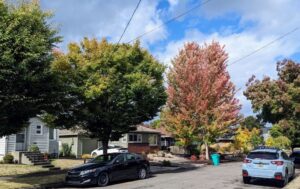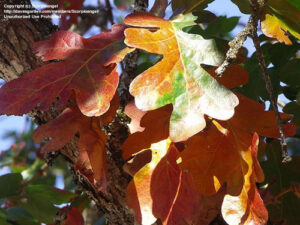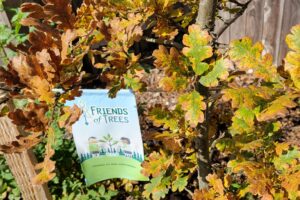Category: Trees
Save Our State’s Urban Trees from Tree Code Rollback
Governor Kotek’s HPAC proposes overriding tree codes in favor of development.
Governor Kotek’s Housing Production Advisory Council (HPAC) is currently planning to bring forward recommendations that include the overriding of tree codes for plots smaller than 6,000 square feet, which will explicitly allow clear cutting of trees under 48″ diameter, which includes the vast majority of urban trees. This recommendation stands in stark contrast to work taking place throughout the state and nation to increase tree cover as a key tool for growing climate-resilient cities. Read more here.
HPAC has a hearing on Friday, September 29th where this facet of their proposal will be discussed.
We recognize the urgent need for affordable housing, but housing and trees should not be mutually exclusive. Friends of Trees, the Shade Equity Coalition (we’re a member!), and many other environmental organizations around the state believe the proposal is unnecessarily pitting the housing and climate emergencies against one another. Unfortunately, this advisory body in question does not have a representative from the environmental justice sector to speak to shade equity, climate change, and the myriad of benefits urban trees provide to Oregonians. This is our chance to voice our concerns.
HOW TO TESTIFY
Since it is difficult to testify at the hearing itself, please make sure to submit written testimony to: [email protected] and copy [email protected].
Suggested Talking Points from Trees for Life Oregon
—At a time of climate crisis, throwing climate- and tree-related regulations out the window is a misguided, short-sighted way to speed up housing construction—and a sure way to guarantee that the state and its cities and towns will be unable to meet their own planned climate and canopy goals.
—Many factors affect developers’ ability to build more affordable housing faster. Tree protections are hardly key among them. Portland’s tree code gives developers the option of paying fees to remove trees in lieu of preserving them. Builders have been paying these fees as they do other business expenses, deeming them worth it in order to build more revenue-generating units or a larger single home whose price will more than cover any tree-removal fees they might have paid. Moreover, simply doing away with tree protections will not guarantee that builders will create more affordable housing.
—We oppose HPAC’s proposal to essentially override municipal tree codes like Portland’s that took many people many years and much effort to put into place. Tree codes were created to ensure Oregon remains a livable place we can all be proud to live in. The Portland tree code, for one, was in the end strongly influenced by developers and is already weak as is.
—We oppose HPAC’s recommendations to erode state and local wetland and environmental zone protections. Such changes will certainly impact trees.
—Governor Kotek’s HPAC is proposing to do away with environment regulations that developers have wanted to eliminate for years. When selecting HPAC’s members Governor Kotek did not include broader voices that would reflect the reality that we are facing both a housing and a climate crisis, and that both need to be addressed in an integrated way.
We hope you’ll take this opportunity to let your voice be heard.
TREE SALE!
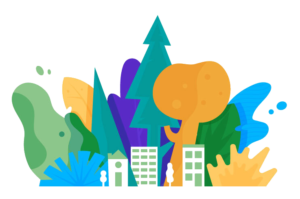
CELEBRATE EARTH DAY with our Annual Shade Tree Sale!
Saturday, April 22, 10am-2pm.
Friends of Trees office, 3117 NE MLK Blvd, north parking lot

✅ Over 200 trees available, ranging from small to large
✅ Prices from $25 – $100
✅ Assistance with tree selection
✅ Loading assistance
🚫 Planting assistance 🚫 Delivery of trees 🚫 A list of tree before the event 🚫 Reserving trees before the event
Don’t miss this unique opportunity to get a quality tree at a discount!

The Year of the Oak
Consider a climate resilient oak tree for your yard this year!
As we kick off planting season, many people are selecting which trees they want planted in their yards. This year, we invite you to consider an oak tree!
There are many species of oaks, which comprise the genus Quercus of the beech family, Fagaceae. North America alone has about 160 species of oak. We want to highlight the amazing power of oaks and showcase some of the oaks we have in the store this year, from the climate resilient Oregon white oak you probably recognize to more unique varieties like kindred spirit oaks and bamboo leaf oaks. We’ve got oaks of different size and character, so please reach out to us to chat about which one might be right for your yard!
We’ve talked before about how we love oaks—even our mascot is an oak tree! Oak trees are particularly good providers to their ecological community, from significantly contributing to the food web to managing the watershed to storing carbon. In those regards, it’s one of the most productive things you can put in your own yard.
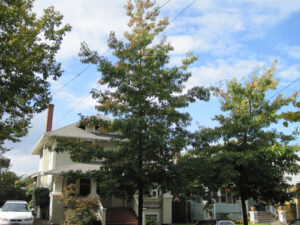
“We get a lot of oaks each season,” says Neighborhood Trees Senior Specialist Drew Land. “As a genus, they are an effective resource against climate change. And I want people to know that!”
Stay tuned to our social media feeds as we highlight awesome species like willow oak, a favorite among our specialists, and swamp white oak, a tree that does remarkably well in the urban environment, and more!
Leaflet: Why We Love Oaks
We love oaks and you should too!
At Friends of Trees, we are particularly fond of oak trees, so much so that our mascot is Garry Oak. For our tree experts, it’s a go-to tree for reasons that go beyond its iconic nature.
“We got a lot of oaks this season,” says Neighborhood Trees Senior Specialist Drew Land. “As a species, they are an effective resource against climate change. And I want people to know that!”
A recent study published in Tree Physiology found that when mature oak trees were bathed in levels of CO2 equivalent to what is expected in 2050, the trees increased their rate of photosynthesis up to a third in response.
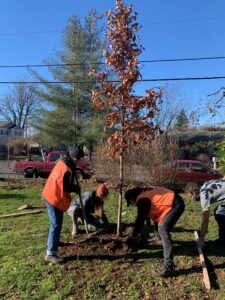
Some folks are reluctant to plant oak trees because they drop a lot of leaves. But we have learned that it’s healthier for your yard to leave the leaves, so that shouldn’t discourage you. Oak leaves are high in tannic acid and don’t decompose as immediately as other species, so they make for particularly good mulch.
Oak trees are particularly good providers to their ecological community, from contributing to the food web to managing the watershed to storing carbon. In those regards, it’s one of the most productive things you can put in your own yard.
“You plant an oak in your yard, you’re planting a zoo,” says Douglas W. Tallamy, author of The Nature of Oaks. “It’s your chance to create life that didn’t exist in that space.”
Oaks are the backbone of our local food chains and are crucial to feeding native insects, which feed the native and migratory birds and small mammals. The Willamette Valley was an Oregon White Oak savannah for 10,000 years. It doesn’t get any more native than that!
“Thankfully, we do plant loads of Oregon white oaks, which is the most important oak species locally,” Drew says. “But the more we plant, the better.”
Tree Care + Equity
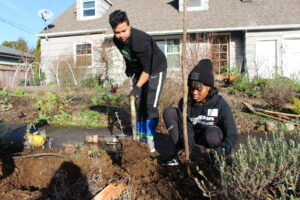 Most people by now are fairly well attuned to the benefits of trees environmentally, socially, mentally, and more. However, less people are aware of how tree canopy is distributed among a city and its neighborhoods.
Most people by now are fairly well attuned to the benefits of trees environmentally, socially, mentally, and more. However, less people are aware of how tree canopy is distributed among a city and its neighborhoods.
A trend across the country in large cities is that trees, and the benefits they bring, are distributed inequitably across neighborhoods based on race and income. Higher income neighborhoods with majority white residents have over 75% tree canopy coverage as compared to lower-income neighborhoods with around 15-30% canopy cover. These are large discrepancies that result in hotter environments, more air pollution, and factors contributing to respiratory conditions like asthma for children.
These trends are reality here in Portland: west Portland (excluding Forest Park) has about 75% canopy cover in most neighborhoods, while east Portland neighborhoods average about 15-30% canopy cover. Friends of Trees prioritizes planting street and yard trees in neighborhoods on the eastside of Portland to help decrease this disparity.
However, many people are wary about – if not outright opposed to – getting a tree of their own because of the costs of tree care, which can increase as a tree grows. This is just one of the reasons Friends of Trees provides tree care along with tree planting, including proper pruning of young trees at no cost to the property owner. And we’re exploring ways to increase the availability of low to no cost tree care for folks who need it, because we know the benefits of trees far outweigh the costs.
In the City of Portland, tree care and maintenance costs are the responsibility of the tree’s adjacent property owner. This is an inequitable financial burden for low-income households, renters, and populations vulnerable to gentrification. Many communities of color cite the financial burdens that a mature tree can bring as a reason to not want to plant trees next to their houses. It’s important to address these very valid concerns since trees have so many benefits, which is why Friends of Trees is continually working on creating programming that is responsive to community needs; in fact, we have funding proposals pending with Portland’s Clean Energy Fund that would help subsidize costs of mature tree care so we can grow our already considerable post-planting tree care services.
Understanding concerns about tree care
In 2018, Friends of Trees partnered with APANO and LARA Media to conduct three focus groups toward better understanding how community members viewed neighborhood trees and tree planting efforts. To increase accessibility these focus groups were conducted in multiple different languages including Vietnamese, Mandarin, and Spanish. Overall, many community members cited the benefits of trees within the city, including their health and environmental benefits:
“Trees are good for the lungs. They are the lungs of the city.”
“In the city, there’s big trees that make the air cooler. It also makes the city greener.”
–participants from the Vietnamese focus group
However, when asked if there are barriers for them to plant trees, many community members cited the long-term costs associated with mature tree care. One participant said: “One of the negatives is that sometimes Portland has a lot of storms and trees fall down when there’s strong wind. I experienced that once. The tree can fall into the house and collapse the house. Usually I try to hire a professional to cut the tree, but it [can cost] thousands of dollars. The tree bothers us.”
Trees and access to the natural environment are integral to healthy, livable neighborhoods. The benefits trees bring are strongest when they are mature, at least 10-15 years after they are planted. However, the fears community members have about the costs trees may bring are also valid, especially since the median household income on the eastside of Portland is lower and there are fears of being pushed out.
Friends of Trees is committed to equitably growing the urban forest through community-centered tree plantings. We offer tree care for the first three years of a tree’s life after it’s planted, including affordable (or free if cost is a prohibiting factor) summer watering service; free mulch; and structural pruning provided at no cost (see the next story for more about our pruning program). Structural pruning on a young tree is vital for its long term health, and can help prevent limbs falling onto a house or car later on in its life, since we can prune for the built environment and the tree will grow into that structure.
However, Friends of Trees also recognizes there are long term costs and concerns that need more support within our communities to make sure the urban forest is distributed equitably. We are continually working on creating programming that is responsive to community needs and when the opportunity arises we pursue grant funding to help subsidize costs of mature tree care. Because we know that, all in all, the positives of trees far outweigh the negatives; as our good friends at J Frank Schmidt like to say, “Trees are the answer.”
Photo: Street tree planting in east Portland, January 2020.

